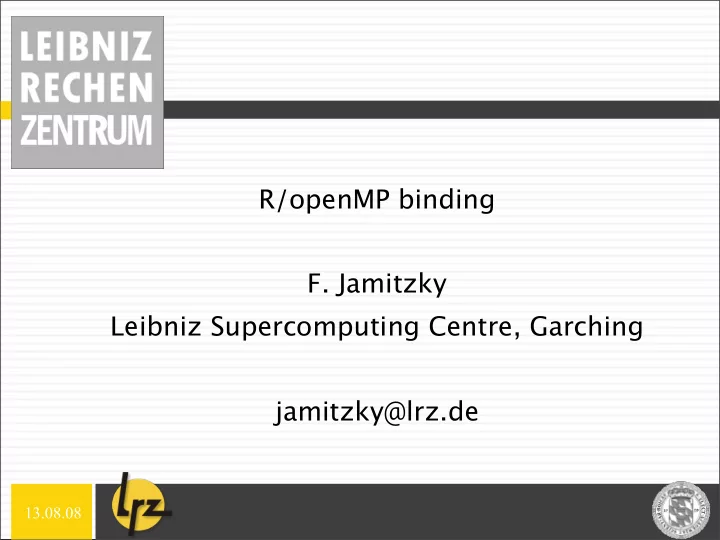

R/openMP binding F. Jamitzky Leibniz Supercomputing Centre, Garching jamitzky@lrz.de 13.08.08
Why ROMP? Put R on the Supercomputer (1000s of cores) Start R on each core? slow! Lightweight approach: openMP R Syntax to Fortran Converter Accelerate R code by compilation Parallelize R code by vectorization Speedup by Compilation: ~100 Speedup by Vectorization: ~100 Total Speedup: ~10000 13.08.08
Why R? Very high abstraction level Lisp roots - “code that writes code” Interactivity – “Instant gratification” Fast prototyping language Huge Libraries - “Batteries included” Graphics and Plots - “nice and shiny” 13.08.08
Why Fortran? Well suited for numerical programming (very fast) Array arithmetics (syntax similar to R) Excellent R bindings (parts of R are written in Fortran) 13.08.08
Why openMP? Abstraction for vector processing Excelent Fortran bindings (Fortran and C are reference languages) Standard in high performance computing Excelent implementations, Fortran/openMP compiler from: GNU, Intel, IBM, NAG, Microsoft (no more), Generated code for many di fg erent CPUs and OSs. 13.08.08
Philosophy Use functional programming style Use closures R functions to Fortran functions in the “ contains ” part. Higher order functions: map/reduce Translate map/reduce to openMP for/reduce pragmas (uses the gsubfn package from http://code.google.com/p/gsubfn ) 13.08.08
Abstractions R functions are translated to “pure” functions in Fortran R “ sum ” is replaced by “ sum.mp ” R “ apply ” is replaced by “ apply.mp ” Typing required, implemented types: int, double 13.08.08
Example Compute distance of two vectors: x <- as.double(runif(100)) y <- as.double(runif(100)) for(i in 1:100) res <- res+(x[i]-y[i])**2 Using ROMP calls: sum.mp(dosum,(x[i]-y[i])**2, dbl(),i=1:100) dosum.f <- compile.mp(dosum(), dbl(),x=dbl(100),y=dbl(100)) dosum.f(res=res, x=x, y=y) 13.08.08
Non-trivial Example: Pointwise Fractal Dimension Compute pointwise dimension of a cloud of points Let N be the density of points at location x where each point is smoothed with radius r The fractal pointwise dimension is then defined as: Ref: Local Scaling Properties for Diagnostic Purposes by W. Bunk, F. Jamitzky, 13.08.08 R. Pompl, C. Rath and G. Morfill, Springer 2002
Pure R style (verbose) Compute local density of point set: dist <- function(i,j,x,r) ifelse(sum((x[i,1:ndim]-x[j,1:ndim])**2)>r**2,0,1) dens_one <- function(j,x,r) sum(sapply(1:np, function(i) dist(i,j,x,r))) comp.dens <- function(x,r) sapply(1:np, function(j) dens_one(j,x,r)) comp.dens(x, r=0.1) 13.08.08
“ROMP in style” Compute local density of point set: sum.mp(dens_one, ifelse(sum((x[i,1:ndim]-x[j,1:ndim])**2)>r**2,0,1), int(), i=1:np, j=int()) apply.mp(dens, dens_one(j), int(np), j=1:np) comp.dens <-compile.mp( dens(), int(np),x=dbl(np,ndim),r=dbl(),ndim=int(),np=int()) comp.dens(x, r=0.1, ndim=3, np=100000) 13.08.08
Benchmarks openmp on SGI Altix 4700 / 512 cores np=10000 Pure R: time = 21800s = 6h!! ROMP: nproc=1 time = 3.2s ROMP: nproc=8 time = 0.6s Acceleration factor: >30000 !! 13.08.08
Benchmarks ROMP ROMP on HLRBII npoints=10000 nproc < 32 scaling up to 10 cores due to small problem size use “first touch” 13.08.08
Rmpi Rmpi http://www.stats.uwo.ca/faculty/yu/Rmpi Rmpi: spawn R interpreter on each core applyLB MPI with load balancing library(Rmpi) mpi.bcast.Robj2slave(x) mpi.applyLB(1:np, function(i) sum(sapply(1:np, function(j) ifelse(sum((x[i,1:ndim]-x[j,1:ndim])**2)>r**2,0,1) )))) 13.08.08
Benchmark Rmpi Rmpi on HLRBII SGI MPI npoints=10000 nproc < 64 strong scaling up to 100s cores 13.08.08
Summary and Outlook ROMP scales up to ~100 cores (SMP) Acceleration factor up to 10000 Pre Alpha Version Combination Rmpi+ROMP? Extending map/reduce: Use monads? Type inference aka automatic typing? 13.08.08
Download 17 download the latest version from: http://code.google.com/p/romp and find more information at: http://romp.r-forge.r-project.org 13.08.08
Recommend
More recommend